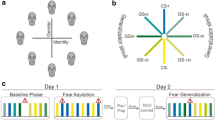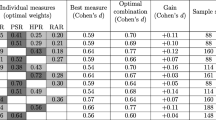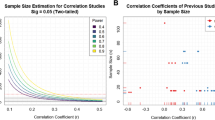Abstract
According to one formulation of the behavioural functions of 5HT, aversive conditioned stimuli mediate their behavioural and emotional effects through activation of 5HT projections from dorsal raphe nucleus to receptors of the 5HT2 family in amygdala and elsewhere. To test this theory in humans, groups of ten normal volunteers received placebo, the 5HT2/1c antagonist ritanserin (10 mg PO) and no pill. Ritanserin had no effect on skin conductance level, variability (spontaneous fluctuations) or habituation to a sequence of ten neutral tones. After a conditioning trial in which tone 11 was followed by an aversive white noise, skin conductance responses to a further ten tones were enhanced. This effect was abolished by ritanserin. The results indicate a selective involvement of 5HT2/1c receptors in modulating aversively conditioned skin conductance responses.
Similar content being viewed by others
References
Ashcroft K, Guimarães FS, Wang M, Deakin JFW (1991) Evaluation of a psychophysiological model of classical fear conditioning in anxious patients. Psychopharmacology 104:215–219
Ceulemans DLS, Hoppenbrowers MLJA, Gelders YG, Reyntjens AJM (1985) The influence of ritanserin, a serotonin antagonist, in anxiety disorders: a double-blind placebo-controlled study versus lorazepam. Pharmacopsychiatry 18:303–305
Charney DS, Woods SW, Goodman WK, Rifkin B, Kinch M, Aiken B, Quadrino LM, Heninger GR (1986) Drug treatment of panic disorder: the comparative efficacy of imipramine, alprazolam, and trazodone. J Clin Psychiatry 47:580–586
Davis M (1989) The role of the amygdala and its efferent projections in fear and anxiety. In: Tyrer P (ed) Psychopharmacology of anxiety. Oxford University Press, Oxford
Deakin JFW (1988) 5HT2 receptors, depression and anxiety. Pharmacol Biochem Behav 29:819–820
Deakin JFW (1989) Role of 5HT receptor subtypes in depression. In: Archer T, Bevan P, Cools A (eds) Behavioural pharmacology of 5HT. Lawrence Erlbaum, New York
Den Boer JA, Westenberg HGM (1990) Serotonin function in panic disorder: a double-blind placebo controlled study with fluvoxamine and ritanserin. Psychopharmacology 102:85–94
Eysenck HJ (1979) The conditioning model of neurosis. Behav Brain Sci 2:155–199
Eysenck HJ, Eysenck SBG (1964) Eysenck personality inventory. University of London Press, London
Fowles DC (1988) Psychophysiology and psychopathology: a motivational approach. Psychophysiology 25:373–391
Fuxe K, Ogren S, Agnati L, Gustafsson JA, Jonsson G (1977) On the mechanism of action of the antidepressant drugs amitriptyline and nortriptyline. Evidence for 5-hydroxytryptamine receptor blocking activity. Neurosci Lett 6:339–343
Goldberg DP, Bridges P, Ducan-Jones P, Grayson D (1987) Dimensions of neuroses seen in primary care settings. Psychol Med 17:461–470
Graeff FG (1989) Serotonin and aversion. In: Bevan P, Cools AR, Archer T (eds) Behavioural pharmacology of 5-HT. Lawrence Erlbaum, New York
Gray JA (1982) The neuropsychology of anxiety: an inquiry into the functions of the septo-hippocampal system. Oxford University Press, Oxford
Gray JA (1987) The psychology of fear and stress, 2nd edn. Cambridge University Press, Cambridge
Guimarães FS, Hellewell J, Hensman R, Wang M, Deakin JFW (1991) Characterization of a psychophysiological model of classical fear conditioning in healthy volunteers: influence of gender, instruction, personality and placebo. Psychopharmacology 104:231–236
Hodges H, Green S, Glenn B (1987) Evidence that the amygdala is involved in benzodiazepine and serotonergic effects of punished responding but not of discrimination. Psychopharmacology 92:491–504
Iversen SD (1984) 5-HT and anxiety. Neuropharmacology 23:1553–1560
Jennen-Steinmetz C (1989) Synopsis of repeated measurement analysis. J Psychophysiol 3:193–194
Jensen HH, Hutchings B, Poulsen JC (1989) Conditioned emotional responding under diazepam: a psychophysiological study of the state dependent learning. Psychopharmacology 98:312–397
Johnstone EC, Cunningham Owens DG, Frith CD, McPherson K, Dowie C, Riley G, Gold A (1980) Neurotic illness and its response to anxiolytic and antidepressant treatment. Psychol Med 10:321–328
Kataoka Y, Shibata K, Yamashita K, Ueki S (1987) Differential mechanisms involved in the anticonflic action of benzodiazepines injected into the central amygdala and mammilary body. Brain Res 416:243–247
Khan RJ, McNair DM, Lipman RS, Covi L, Rickels K, Dowing R, Fischer S, Frankenthaler LM (1986) Imipramine and chlordiazepoxide in depressive and anxiety disorders. Arch Gen Psychiatry 43:79–85
Lader M (1975) The psychophysiology of mental illness. Routledge & Kegan Paul, London
Pangalila Ratu-Langi EA, Janssen AAI (1988) Ritanserin in the treatment of generalized anxiety disorder: a placebo-controlled trial. Hum Psychopharmacol 3:207–212
Peroutka SJ, Snyder SH (1980) Long-term antidepressant treatment decreases spiroperidol-labelled serotonin receptor binding. Science 210:88–90
Petersen EN, Scheel-Kruger J (1984) Anticonflict effects of 5-HT antagonists by intraamygdaloid injection. Collegium Internationale Neuro-Psychopharmacologium, 14th CINP congress book of abstracts: 654
Soubrie P (1986) Reconciling the role of central serotonin neurons in human and animal behaviour. Behav Brain Sci 9:319–364
Venables PH, Christie MJ (1980) Electrodermal activity. In: Martin I, Venables PH (ed) Techniques in psychophysiology. John Wiley, Chichester
Author information
Authors and Affiliations
Rights and permissions
About this article
Cite this article
Hensman, R., Guimarães, F.S., Wang, M. et al. Effects of ritanserin on aversive classical conditioning in humans. Psychopharmacology 104, 220–224 (1991). https://doi.org/10.1007/BF02244182
Received:
Revised:
Issue Date:
DOI: https://doi.org/10.1007/BF02244182




